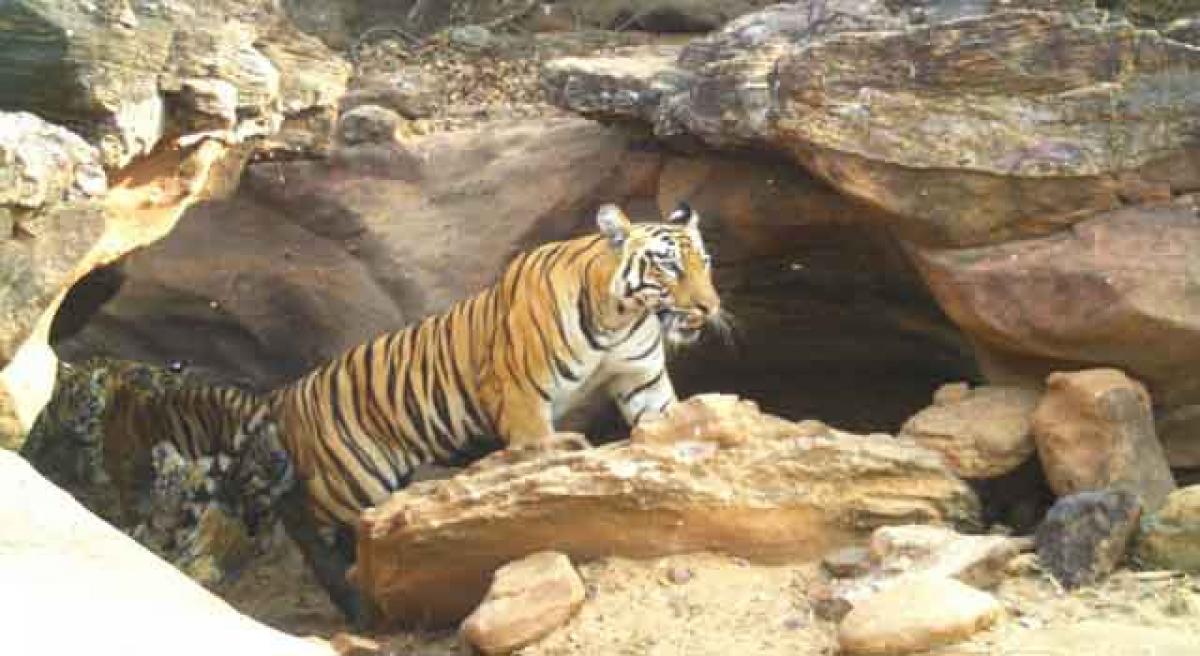Live
- TTD closes Akasaganga, Papavinasam roads
- High costs, limited results: Drone mist-spraying pilot project faces setback
- Poster war on as parties compete for voter attention
- Many dams, tanks filled as rains batter Tirupati dist
- Mayawati, Akhilesh condemn damage to Constitution replica
- Mann slams Centre over ‘one nation, one election’
- Techie suicide case: Mother-in-law flees Jaunpur home
- State government to Supreme Court: New guidelines on how to apply anti-gangster law in UP
- CM Chandrababu to unveil Vision 2047 document today in Vijayawada, traffic restrictions imposed
- State-level LIMES-2k24 inaugurated
Just In

The dense Kagaznagar forest is set to echo with the growls of tigers as the number of big cats is on the rise. With the migration of a few big cats to the district from neighbouring Tadoba Andhari Tiger Reserve in Maharashtra in recent times, the number of tigers in the forest increased to nine.
Adilabad: The dense Kagaznagar forest is set to echo with the growls of tigers as the number of big cats is on the rise. With the migration of a few big cats to the district from neighbouring Tadoba Andhari Tiger Reserve in Maharashtra in recent times, the number of tigers in the forest increased to nine.
According to forest officials, two tigers shifted their base to the Kagaznagar forest from Tadoba reserve in 2014. The names of big cats are Chaitra and Vaisakha. Phalguna and Phalguna 2 joined them in 2015.Phalguna, which mated with Vaisakha, gave birth to four tiger cubs. The cubs are now seven months old.
The CCTV cameras arranged by the forest officials captured the images of the tigress and its cubs while they were moving at a cave in the Lakshmipur forest of Sirpur area, which is located in the vicinity of Bheemanna temple.
The rise in tiger population in the Kagaznagar forest is attributed to abundant wildlife and adequate water resources to meet their food and drinking needs. The forest is inhabited by deer, hill goats, buffaloes, nilgai and other wild animals. Pranahita and Wardha rivers flow through the forest.
Speaking to The Hans India, Kagaznagar DFO Raviprasad said: “There are about 70 tigers in the Tadoba r reserve. The number of tigers in Chanda area is put at 20. According to an estimate, there are 15 tigers in Chandrapur forests.
The tiger population in the region is poised for growth in the coming years due to ideal environs. Bellampalli, Vemanapalli, Mancherial and other areas adjacent to the Kagaznagar forest are likely to witness increase in movement of tigers in the near future.’’
Anticipating the growth in tiger population in the area, the Forest Department initiated several measures to prevent them from straying into the human habitations in the fringe areas of Kagaznagar for food and water.
Some deer brought from Hyderabad were released into the deep forest to enable the tigers to hunt for food. It was also proposed to release 200 more deer into the wild to enable the big cats to hunt. There is also a proposal to release sheep and goats into the forest for the food needs of the big cats.
A campaign was taken up in the fringe areas of the forest to create awareness among people about the Project Tiger aimed at conserving the national animal. A compensation of Rs 4.5 lakh was paid to the farmers who lost their livestock in the big cat attacks last year.
Water pits were dug up in the deep forest to prevent tigers from straying into human habitations to quench their thirst. Solar pumpsets were also installed in the forest to ensure adequate supply of drinking water to the wild animals.
Plans are afoot to dig 30 more pits in the deep forest to meet the drinking needs of big cats. A 30-member special team headed by an official of the rank of deputy forest officer was set up to curb poaching in the area. About 30 CCTV cameras were also set up to monitor the movement of wild animals in the deep forest.
The DFO said: “The prospects of Kagaznagar forest becoming an ideal habitat of tigers are good. We are coordinating with the revenue and police departments to meet the requirements of growing tiger population in the forest and to ensure the safety of big cats.’’
By: T Anjaiah

© 2024 Hyderabad Media House Limited/The Hans India. All rights reserved. Powered by hocalwire.com







